|
TennisOne Lessons Playing by a New Set of Rules Doug King Tennis can be appreciated as a game of beauty on so many levels. The movements are both flowing and graceful with an elegant lyricism and then powerful and primal with forceful exertions of conviction and will. The play between attack and defend has a dynamic exchange that breathes in and out with a tidal rhythm. Even the score, with no clock to protect you or lead to cushion you, has a beauty that is rooted in hope and challenges one’s mindfulness. Another form of beauty I have come to appreciate in the game is the symmetry that ties everything into a magnificent tapestry of interrelated and mutually supporting principles. I have heard physicists speak of the awesome beauty that ties the natural world together through a web of physical laws. Through my experience with tennis, I have an appreciation of this marvel of which they speak, for truly this beauty is evident in the way the game is connected. I will try to express my view on this connectedness through an examination of the volley stroke. In the process I hope to paint a clear understanding of the mechanics and the mysteries of one of the subtlest arts in the game.
Let me start by questioning the way we have come to learn and teach the game of tennis, and even denounce my previous statement in the process. I do not believe in teaching “strokes,” instead I believe in teaching “stroking.” To me there is a huge difference. To break down the game into groundstrokes, volleys, overheads, and serves is a capitulation to convenience and comfort. It gives people learning the game a sense of security, of concreteness and it provides the instructors with a sense of control, of right and wrong. This approach unfortunately puts the game into a language that is not only static but, by its very expression, misdiagnoses the real principles that form the bones of the game. To me there is only one true stroke to the game - it is performed forwards and backwards, high and low, to the right and the left. This stroke is found in the understanding of the transfer of energy that exists in the contact of the ball. My belief is that as we come to fully understand the nature of contact we will see the interaction between the ball and strings as something that is full of exchange - and “change” will be thing we see most. Change of direction, change of spin, change of shape - the ball inbounds and is compressed and deflects the strings back, the strings absorb the power of the ball and catapult the ball forward as they return to form. And within ourselves we reflect the same changes that occurs between ball and racquet, going from flexed to straightened, slow to fast, relaxed to tensed, reactive to active. Within this exchange is the true nature of "stroking" in all of it's complexities, both positive and negative. We are taught strokes by positions, starts and finishes, with little attention to the most critical aspect of the entire stroke - the contact. In reality, good stroking is nothing more than learning to modulate the natural energy exchange between the racquet and the ball by using our bodies as coils, springs, and levers. We are coerced through fear tactics and ignorance to believe that we have no control over this interaction, that it is too fast to see, that we have too little time to influence the forces involved, that we have no control over this exchange. In fact, we are told we are better off ignoring this moment and instead instructed to hit "through" it. Don’t believe it! You can see it in great players, you can hear it, every sense confirms that they possess a “magical” touch. It is complex, yes, it is subtle, yes, but there is nothing magical about it. It is all there if we look in the right place. It is in the gray area of contact that this touch resides rather than the black and white positions that we have been indoctrinated with. The Underspin Volley and the Catch of the Ball Before you are too quick to point out my hypocrisy, let me preface by saying there is no one volley. There is a drop volley and an angled volley, a lob volley, a drive volley, a punch volley, and a topspin volley. The volley is defined not by a specific “form” but by a convergence of circumstances. The height of the ball, speed of the ball, proximity of player to the net, available reaction time, and the intended target are but a few of the circumstances that define a volley. But we can, however, speak in probabilities. For example, the volley rarely occurs behind the baseline (let’s hope) and since by definition it is played in the air, there is a higher incidence of it occurring closer to the net. As we get closer to the net, the balls that are encountered have more velocity (as much of the velocity is lost on the bounce) and the length of distance that we have to hit the ball is reduced. Add to this to the fact that we are often moving forward to improve positioning as we volley, the sum of these circumstances dictates that for many volleys there is a high premium on absorbing pace off the incoming ball. Therefore, I am using the underspin volley as a study in the technique of absorbing pace.
We sometimes call this “catching” the ball and this is not uncommon advice for volleying. Catching, however, is not as simple as it seems, especially when it involves a fast moving bouncy ball on a springy tennis racquet. I play catch with my dog using a tennis ball and my dog (a Border Collie/Aussie mix) is a magnificent example of coordination and athleticism. As incredible an athlete as she is, catching the ball is a random act for her. More often than not the ball ricochets out of her snapping jaws like some berserk projectile. I watch her make that stabbing action at the ball and I think to myself, “How many times have I seen that volley on a tennis court.“ Sadly there is no one to blame but the teachers who tell people to keep a firm wrist, block the ball, step out to the ball, don’t swing, or (worst of all) punch the ball. Catching the ball is more than closing your fingers around the ball as it lands in the palm of your hand. There is a withdrawing of the hand as the ball approaches and enters the palm that allows the hand to “accept” the ball. There is a turn of the forearm that further enhances this absorption. There is timing and blending of the movement of the hand and the ball that allows them to “connect.” It is through this “connection” that energy is exchanged. This withdrawing with the ball represents a “negative” or backwards connection to the ball or a backwards “follow” of the ball. It is exactly the same in nature as the connection that occurs when I add power to the ball, but only in reverse. They are exactly the same in their polarity - they are positive and negative twins. One is a backward follow and the other is a forward follow. This is really what follow through is about. It is the delicate following of the ball that occurs in the exchange of force between the ball and the racquet. (See "The Topspin Backhand and How We Lost Our Way: Part 2" section "Rules of Engagement" for more about connecting and transferring energy) We have been taught the follow throughs are positions that we end up in at the completion of a stroke. These positions may have relevance for beginners or for other aspects of stroking such as balance but they have come to supercede the more important issue of the interplay between ball and racquet. This, to me, is the true meaning of follow through. It is the subtle texture of “connection” between ball and racquet that occurs through contact. It can occur in a forward, positive follow which enhances the spring out of the ball from the racquet or it can occur in a backward, negative follow which enhances the absorbtion aspect of contact. Almost all of the significant follow through is within a leveraged turn of the ball. Leverage and the Most Difficult Thing in Sport The hand and forearm work like a mini-lever that can flex back and forward with delicate nuance. When the tip of the racquet is pointed forward (towards the net) the racquet is in position to accept the ball. This accepting is done by letting the tip of the racquet subtly flex back with contact. A continental grip helps to keep the racquet in this position. This is often ideal in volleying when one encounters shots with great pace and where one has less time to prepare. It requires less time to prepare the racquet into this position, as flexing back requires more time. Here we can see an example of the beauty of how these techniques and principles interact and support each other in a magnificent web of mutual purpose.
The racquet is also ideally set to perform the desired function of absorbing. In contrast, when the tip of the racquet is folded back it is in a position to perform positive follow of the ball. This forward follow through enhances the catapulting of the ball, adding force in the process. This is exactly how a pinball lever is set, that is, to accept the ball and fire it forward by releasing the tension that is built up in the folded back position. This position of flexing back requires more time to get into and is appropriate when there is need and opportunity to add pace to a ball. This forward and backward follow of the ball is executed subtly in the wrist but primarily with rotational movement in the forearm. This is the meaning behind leverage. Leverage is using the mass of the body to advantage as a power source. In traditional teaching techniques we have tended to emphasize the use of the body to increase the speed of the racquet. Admonitions such as “step in,” “move in,” and “turn in” all have an implication that the body leads the hands in order to increase racquet speed. However, this only increases the centrifugal pull of the racquet on the body which in turn, forces the body to tighten in order to resist this pull. This is directly contrary to the physics of leverage which dictate that the body weight is positioned and timed to drive the “lever” which is the forearm/wrist. In reality, to properly shift into a power position the body compresses behind the racquet as the elbow drops and falls into the body. This sets the spring (the body) into a strong coil and brings the hand and racquet into a position to accept the ball and create proper connection for an efficient transfer of energy through a release of the spring and a subsequent leveraged turn of the ball from the forearm. This is exactly how a pinball lever works. You must wait for the ball to get into the correct position to apply leverage. If you spring to early you have no power. This is why when we emphasize racquet speed we end up overswinging, firing our weight shift too early, abusing our weight shift and abusing the racquet/ball connection. The racquet is the least swinging element in the entire stroking process, and I cannot emphasize this enough.
If you look at the position of the racquet in almost all topspin forehands you will see the tip of the racquet pointed down and flexed back behind the hand as it approaches contact. Certain grips (full Eastern and semi Western) encourage this flex, and in fact, actually force this winding and buildup of tension in the forearm simply to get the racquet into a square contact position. In addition, you will see the body positioned and the weight shift timed to properly drive this lever mechanism. As you look at the corresponding pictures, look at the racquet as a pinball lever and the body as a spring that coils and uncoils, flexes and straightens, to release power that drives the lever. Imagine how the tennis ball is acting like a pinball to roll into the flexed position and how the release of power is held back until the last moment to drive it. Notice also how the racquet is held back on the side of the body through contact rather than snapping forward. The momentum, the swing, never gets into the racquet head. The truth is that most people are far too early on their shots. They step in too much, they swing too quickly, they swing too fast, they really don’t know where power should come from. The more we talk about racquet speed the more we mislead them. As the great baseball hitter and acknowledged master of the science of the baseball swing, Ted Williams, once stated, “The most difficult thing in sport is to wait.”
On the underspin volley, where speed is being absorbed by the hand and forearm, the exact opposite is the case. The tip of the racquet is up and slightly forward of the hand as the ball approaches. The Continental grip will tend to produce this position. It will set the racquet into a hitting position not by winding and compacting the arm but just the opposite, by extending the arm back and away from the body. This is a naturally weak position that will make it easier to absorb rather than generate power. With the Continental grip the contact occurs in weak, extended positions void of coil, flex, and stored energy. As the ball approaches contact, the arm comes into the body with an outside to inside pull. This outside to inside pull in the shoulder also produces a natural high to low movement in the arm. At the same time the racquet folds back and down at contact through a controlled rotation of the forearm in a way that opens the racquet face. This is a key element in the absorbing of the ball. In the underspin stroke the forearm goes into contact with little stored energy. The arm actually increases in flex and coil as it goes through contact in the technique described above. This action produces a “catch” of the ball in exactly the same way that baseball players and football receivers are taught to catch a ball. Hence the grip is key to establishing a contact position that will facilitate a natural absorption of power off of the ball. The nuances of grip usually define the type of volleyer someone is (as it does with all types of strokes). If they use more grip change between forehand and backhand volleys then they will naturally put more pace on the ball and handle the higher, slower hit ball better. They will tend to play “power“ volleys, typically flat or even topped on occasion, but may have trouble on harder hit balls and low balls.
A player who uses a Continental grip will be more adept at taking speed off of the ball and will be more comfortable with touch volleys, low balls, and harder hit balls, using finesse and disguise as his weapon of choice. This is why I believe in “floating“ grips that adjust to the situation (but that is for another time). Note how Lindsay Davenport (above right) keeps the tip of her racquet forward and high and drops in and folds back through contact to absorb pace. Her arm position is away from the body and also helps to weaken contact, as body is less supportive of wrist in this position. A second form of absorption occurs in the body. This is done by flexing the knees down as the contact occurs. This has the effect of absorbing power. If I start in a crouch and then raise out of the crouch I am releasing power. The crouch is stored energy in the form of flex and tension. When I raise up I am releasing energy. Think back to the dog jumping up and snapping it's jaws while trying to futilely catch the ball. When I reverse the process the result is the opposite. That is another reason why we sink with underspin shots, to absorb energy from the ball. We can also hit underspin and push up out of the legs which would add more power to the stroke. Again, it is a matter of understanding the various techniques that one has available to produce the type of shot that one decides to create. The Nature of Underspin - the Bigger Picture Underspin is by nature a negative movement in that it is designed to take speed away from the ball. One may argue with this and point out that you can certainly add power with an underspin stroke and they would be correct. However, let me make a case. Underspin (or backspin) actually lifts the ball and keeps it airborne (the opposite of topspin). The harder you hit it or the more spin you put only increases the chances of it going out. Secondly, the grip and the position of contact that are biomechanically inherent in the stroke are physically incompatible with power. The grip is weak because little of the hand and wrist are aligned for support on the racquet and the position of contact being further away from the body lends less support to the wrist than a full Eastern grip, which is more in front of the body. The logic of these physics makes it incompatible with a power stroke. Although we may identify this weak contact and the tendency of the ball to lift as negative aspects, under certain circumstances they are exactly what are needed. Returning a hard hit low ball close to the net demands taking pace off the shot. When I am stretched out wide and I am deep in the court I need the ball to carry deeper than my leverage will afford. In these situations what I may consider “weak” is actually an asset.
These laws of physics and logic are intertwined with the basic approach that one should apply to an underspin stroke - that is, absorb power. This ties back into the inspiring beauty of how all of these aspects of physics, logic, biomechanics, and strategy weave together to support each other into a powerful, unilateral goal and at the same time create diversity, change, and options by coming out of a unifying element that has the flexibility to bend in different directions. If there is magic, that is it. Negative and Positive Follow Through Power is the culmination of many forces. On the underspin volley we will typically see negative follow in the wrist and forearm rotation, while the feet and the extension of the arm from the shoulder provide positive follow of the ball to add to the forward propulsion of the ball. The modulation of these various forces acts to produce a controlled flow of energy. With most underspin shots what you have, in effect, is controlled “lagging” of the ball for precision depth control, much like lagging a cue ball in pool.
Sampras (right) shows perfect volley technique. Racquet positioning on the upper, outside edge of ball and forearm rotation absorb pace while feet move the body forward and shoulder extends to provide positive follow. These carefully modulated forces combine to produce precision “lagging” of the ball. Negative follow is any movement produced by the body or the racquet that absorbs the power out of the ball by enhancing the compression of the ball into the racquet during contact. (Technically, the only way the racquet intentionally absorbs power off of the ball is to hit off center - which top pros will actually do when attempting drop volleys - and by varying the stringing tension. The rest of the absorbing techniques are done by the body; the wrist and forearm being part of the body). This could be something as simple loosening the grip at contact (a la John McEnroe - a touch shot expert) or falling back on a shot to dip a topspin crosscourt passing shot short. Underspin is, by nature, a negative follow as described above. It can be counteracted by other forces of positive follow, such as a forward weight shift, turn, or extension of the arm. The skill of stroking is being able to master these various techniques. The art of the game is learning to apply them in an effective style reflecting sound judgment. Learning the Techniques Developing the skills of proper underspin volleying is not as complex as it sounds. First start by learning to catch the ball on the racquet. To do this, choke up on the handle and use the racquet like a glove. The left hand helps to secure the ball into the racquet as the racquet moves back with contact to absorb the ball. As your hands go back with the ball and racquet sink in your knees at the same time. These moves will help you to develop the feel of proper “negative follow.”
Next, after catching the ball try throwing it back over the net using both hands to hold the ball to the strings as long as possible. You will naturally stand back up, pushing out of the legs and stepping forward (forward/positive follow) to create forward momentum. Extend the arm (more positive follow) and keep the tip of the racquet back to maintain alignment and connection to the ball (like pushing a pie in someone’s face). Finally try to do this on the move, first walking forward very slowly and then more quickly. The feet also provide an effective means of positive follow through as this allows the racquet to move forward with the ball without changing alignment to the ball and target. You will have to manage your forward movement and slow yourself as you catch the ball but this will teach you how not to rush into the contact and at the same time show you why that is such a bad idea. Within a short time you will get a sense of all of the various forces involved, from negative follow of the forearm to absorb the ball, to positive follow in the extension of the arm and the forward steps of the feet. With practice you will be able to blend them seamlessly into a fluid motion that gives you tremendous control over the ball. In addition you will be able to change the mix to emphasize the absorbing of the ball or the propulsion of the ball, adjusting to the situation and depending upon your judgment. Now go out and play for it is only in play that you will accumulate experience and only through experience you will accumulate judgment. Summation Remember that all shots in tennis are based on the natural forces that occur in the contact between the ball and the racquet. Everything is a reflection, a mirror, or an enhancement of a single, base stroking movement of the body that mimics these forces, positive and negative. The better the player the more that the player can stretch the boundaries of distortion of that base stroke in either direction, without compromising the essence of the stroke; clear vision, precise alignment, solid connection, and efficient leverage. And the better player has a clearer vision of what is appropriate. That vision is what we call judgment and it can only be acquired through experience. So get thee to a practice wall and have at it. Remember what Ted Williams said about waiting. Although the preparation time may be less than that of the groundstrokes, in reality the underspin volley stroke is the slowest stroke in the game, as there is more absorbing and slowing of the ball than with any other stroke. So take your time, and learn to savor the fine art of the underspin volley. Your comments are welcome. Let us know what you think about Doug King's article by emailing us here at TennisOne.
Doug is one of the country's foremost tennis teaching innovators. Founder of Acceleration Tennis, a revolutionary teaching system, King is leading the way in reinterpreting the traditional tennis model. For more information on Acceleration Tennis please email Doug King at dking@meadowood.com. |

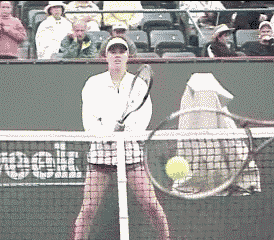
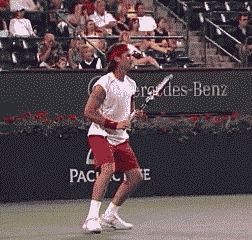
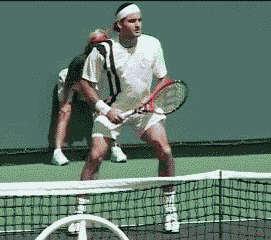
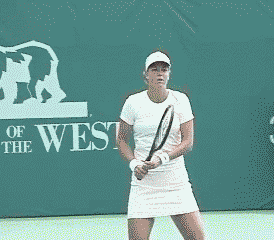
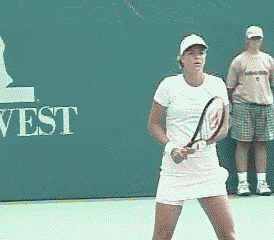
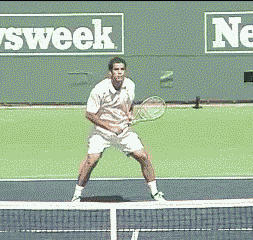
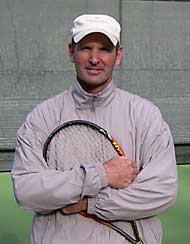
 Doug King studied with legendary tennis coach Tom Stow and was a
former California State Men's Singles Champion
and the former number one men's player of Northern California.
Doug King studied with legendary tennis coach Tom Stow and was a
former California State Men's Singles Champion
and the former number one men's player of Northern California.